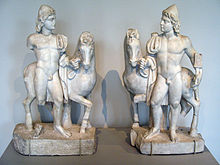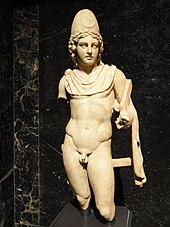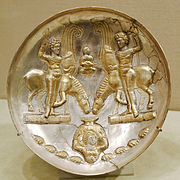Castor and Pollux
| Castor and Pollux | |
|---|---|
Twin gods, patrons of sailors, associated with horsemanship | |
 Statues of Castor and Pollux (3rd century AD) | |
| Other names |
|
| Major cult center | Horses |
| Gender | Male |
| Festivals | Feast of the Dioskouroi (July 15) |
| Personal information | |
| Parents | |
| Siblings | Timandra, Phoebe, Philonoe, Helen of Troy and Clytemnestra |
| Equivalents | |
| Etruscan equivalent | Kastur and Pultuce |
| Indo-European equivalent | Divine twins |
Castor
Their mother was
In Latin, the twins are also known as the Gemini
Birth
There is much contradictory information regarding the parentage of the Dioscuri. In the Homeric Odyssey (11.298–304), they are the sons of Tyndareus alone, but they were sons of Zeus in the Hesiodic Catalogue (fr. 24 M–W). The conventional account (attested first in Pindar, Nemean 10) combined these paternities so that only Pollux was fathered by Zeus, while Leda and her husband
Castor and Pollux are sometimes both mortal, sometimes both divine. One consistent point is that if only one of them is immortal, it is Pollux. In Homer's
The Dioscuri were regarded as helpers of mankind and held to be patrons of travellers and of sailors in particular, who invoked them to seek favourable winds.[3] Their role as horsemen and boxers also led to them being regarded as the patrons of athletes and athletic contests.[4] They characteristically intervened at the moment of crisis, aiding those who honoured or trusted them.[5]
Classical sources
Ancient Greek authors tell a number of versions of the story of Castor and Pollux.
Mythology
Both Dioscuri were excellent horsemen and hunters who participated in the hunting of the
.As Argonauts
During the expedition of the Argonauts, Pollux took part in a boxing contest and defeated King Amycus of the Bebryces, a savage mythical people in Bithynia. After returning from the voyage, the Dioscuri helped Jason and Peleus to destroy the city of Iolcus in revenge for the treachery of its king Pelias.
Rescuing Helen
When their sister Helen was abducted by
Leucippides, Lynceus, and death

Castor and Pollux aspired to marry the Leucippides ("daughters of the white horse"),
The cousins carried out a cattle-raid in
Some time later, Idas and Lynceus visited their uncle's home in Sparta.[12] The uncle was on his way to Crete, so he left Helen in charge of entertaining the guests, which included both sets of cousins, as well as Paris, prince of Troy.[12] Castor and Pollux recognized the opportunity to exact revenge, made an excuse that justified leaving the feast, and set out to steal their cousins' herd.[12] Idas and Lynceus eventually set out for home, leaving Helen alone with Paris, who then kidnapped her.[12] Thus, the four cousins helped set into motion the events that gave rise to the Trojan War.

Meanwhile, Castor and Pollux had reached their destination. Castor climbed a tree to keep a watch as Pollux began to free the cattle. Far away, Idas and Lynceus approached. Lynceus, named for the lynx because he could see in the dark, spied Castor hiding in the tree.[12] Idas and Lynceus immediately understood what was happening. Idas, furious, ambushed Castor, fatally wounding him with a blow from his spear – but not before Castor called out to warn Pollux.[12] In the ensuing brawl, Pollux killed Lynceus. As Idas was about to kill Pollux, Zeus, who had been watching from Mount Olympus, hurled a thunderbolt, killing Idas and saving his son.[12]
Returning to the dying Castor, Pollux was given the choice by Zeus of spending all his time on
Iconography
Castor and Pollux are consistently associated with horses in art and literature. They are widely depicted as helmeted horsemen carrying spears.[13] The Pseudo-Oppian manuscript depicts the brothers hunting, both on horseback and on foot.[17]

On
They were described by Dares Phrygius as "blond haired, large eyed, fair complexioned, and well-built with trim bodies".[20]
Dokana
Dokana were ancient symbolical representation of the Dioscuri. It consisted of two upright beams with others laid across them transversely. The Dioscuri were worshipped as gods of war, and their images accompanied the Spartan kings whenever they took the field against an enemy. But when in the year 504 B.C. the two kings, during their invasion of Attica, failed in their undertaking on account of their secret enmity towards each other, it was decreed at Sparta, that in future only one king should command the army, and in consequence should only be accompanied by one of the images of the Dioscuri. It is not improbable that these images, accompanying the kings into the field, were the ancient δόκανα, which were now disjointed, so that one-half of the symbol remained at Sparta, while the other was taken into the field by one of the kings.[21]
The name δόκανα seems that it comes from δοκός which meant beam, but Suda and the Etymologicum Magnum state that δόκανα was the name of the graves of the Dioscuri at Sparta, and derived from the verb δέχομαι.[21]
Shrines and rites

The Dioskouroi were worshipped by the Greeks and Romans alike; there were temples to the twins in Athens, such as the Anakeion, and Rome, as well as shrines in many other locations in the ancient world.[22]
The Dioskouroi and their sisters grew up in Sparta, in the royal household of Tyndareus; they were particularly important to the Spartans, who associated them with the Spartan tradition of dual kingship and appreciated that two princes of their ruling house were elevated to immortality. Their connection there was very ancient: a uniquely Spartan aniconic representation of the Tyndaridai was as two upright posts joined by a cross-bar;[23][24] as the protectors of the Spartan army the "beam figure" or dókana was carried in front of the army on campaign.[25] Sparta's unique dual kingship reflects the divine influence of the Dioscuri. When the Spartan army marched to war, one king remained behind at home, accompanied by one of the Twins. "In this way the real political order is secured in the realm of the Gods".[2]
Their herōon or grave-shrine was on a mountain top at Therapne across the Eurotas from Sparta, at a shrine known as the Meneláeion where Helen, Menelaus, Castor and Pollux were all said to be buried. Castor himself was also venerated in the region of Kastoria in northern Greece.

They were commemorated both as gods on Olympus worthy of
The rite of
The image of the twins attending a goddess are widespread
City of Dioscurias
The ancient city of Dioscurias or Dioskurias (Διοσκουριάς) on the Black Sea coast, modern Sukhumi, was named after them. In addition, according to legend the city was founded by them.[30][31] According to another legend, the city was founded by their charioteers, Amphitus and Cercius of Sparta.[32][33]
Island of Dioscuri
The island of Socotra, located between the Guardafui Channel and the Arabian Sea, was called by the Greeks Dioskouridou (Διοσκουρίδου νήσος), meaning "the island of the Dioscuri".
Indo-European analogues
The heavenly twins appear in Indo-European tradition as the effulgent Vedic brother-horsemen called the Ashvins,[2][5] Lithuanian Ašvieniai, and possibly Germanic Alcis.[34][35]
Etruscan Kastur and Pultuce
The
Italy and the Roman Empire

From the 5th century BCE onwards, the brothers were revered by the Romans, probably as the result of cultural transmission via the Greek colonies of Magna Graecia in southern Italy. An archaic Latin inscription of the 6th or 5th century BCE found at Lavinium, which reads Castorei Podlouqueique qurois ("To Castor and Pollux, the Dioskouroi"), suggests a direct transmission from the Greeks; the word "qurois" is virtually a transliteration of the Greek word κούροις, while "Podlouquei" is effectively a transliteration of the Greek Πολυδεύκης.[38]
The construction of the
The Romans believed that the twins aided them on the battlefield.
Castor and Pollux are also represented in the Circus Maximus by the use of eggs as lap counters.[42]
In translations of comedies by Plautus, women generally swear by Castor, and men by Pollux; this is exemplified by the slave-woman character Staphyla in A Pot of Gold (act i, ll. 67–71) where she swears by Castor in line 67, then the negative prefix in line 71 denotes a refutation against swearing by Pollux.[43]
Christianization

Even after the rise of
The New Testament scholar
More directly, the Acts of the Apostles mentions the Dioskouroi in a neutral context, as the figurehead of an Alexandrian ship boarded by Paul in Malta (Acts 28:11).
Gallery
The iconography of Castor and Pollux influenced or has close parallels with depictions of divine male twins in cultures with Greco-Roman relations.
-
Limestone stele from Roman Egypt with a star connected to each twin's head (30 BCE–395 CE)
-
Sassaniansilver platter with warrior twins on winged horses (5th/6th century CE)
-
Byzantine silk textile with elevated twins receiving offerings (7th/8th century CE)
-
One of the Dioscuri from Las Incantadas (2nd cent. CE)
See also
- Ambulia, a Spartan epithet used for Athena, Zeus, and Castor and Pollux
- Alexiares and Anicetus, twin-sons of Heracles/Hercules and Hebe/Juventas; alongside their father, they are the guardians of the gates of Mount Olympus.
- Thracian horseman, sometimes linked to the Dioscuri
- Ashvins, the divine twins of Vedic mythology
- Ašvieniai, the divine twins in Lithuanian mythology
- Lugal-irra and Meslamta-ea, twins gods in Mesopotamian mythology also thought to be represented by the constellation Gemini
- Heteropaternal superfecundation, when two males father fraternal twins
- Janus
- Nio
- A-un
- Gozu and Mezu
Notes
- romanized: Kástōr, lit.'beaver'.
- ^ /ˈpɒləks/ POL-əks; Latin: Pollūx.
- ^ /ˌpɒlɪˈdjuːsiːz/ POL-ih-DEW-seez; Ancient Greek: Πολυδεύκης, romanized: Polydeúkēs, lit. 'much sweet [wine]'.[1]
- koûroi('boys').
- ^ /ˈdʒɛmɪnaɪ/ JEM-in-eye.
- ^ /ˈkæstəriːz/ KAST-ər-eez.
- ^ /tɪnˈdærɪdiː/ tin-DARR-id-ee.[citation needed]
- ^ /ˈtɪndərɪdz/ TIN-də-ridz; Ancient Greek: Τυνδαρίδαι, romanized: Tundarídai.
- ^ In the oration of the Athenian peace emissary sent to Sparta in 69, according to Xenophon (Hellenica VI), it was asserted that "these three heroes were the first strangers upon whom this gift was bestowed."[15]
- ^ Kerényi draws attention especially to the rock carvings in the town of Akrai, Sicily.[28]
References
- ^ Bloomsbury (1996), "Dioscuri", Dictionary of Myth, London: Bloomsbury Publishing
- ^ a b c d Burkert 1985, p. 212.
- ^ a b Cotterell, Arthur (1997), "Dioscuri", A Dictionary of World Mythology, Oxford University Press.
- ^ Howatson, M. C.; Chilvers, Ian, eds. (1996), "Dioscūri", The Concise Oxford Companion to Classical Literature, Oxford University Press.
- ^ a b c Roberts, John, ed. (2007), "Dioscūri", Dictionary of the Classical World, Oxford: Oxford University Press.
- ^ a b c Parker, Robert Christopher Towneley (2003), "Dioscuri", in Hornblower, Simon; Spawforth, Anthony (eds.), The Oxford Classical Dictionary, Oxford University Press.
- ^ Alcæus of Mytilene (1982), "Fragment 34", in David A. Campbell (ed.), Sappho, Alcaeus. Greek Lyric, Volume I: Sappho and Alcaeus.
- ^ Alcæus of Mytilene (May 2011), "Fragment 34a", in Tout Coule (ed.), tout coule.
- ^ Homer, Hymn, Theoi.
- ^ Campbell, David (1967), Greek Lyric Poetry, Bristol: Classical Press.
- ^ Kerényi 1959, p. 109.
- ^ a b c d e f g h i j k l Stratikis, Potis (1987), Ελληνική Μυθολογία [Greek Mythology] (in Greek), vol. II, Athens, Greece, pp. 20–23
{{citation}}: CS1 maint: location missing publisher (link). - ^ a b c "Dioscuri". Encyclopædia Britannica. 2008.
- ^ Routledge (2002), "Castor and Polydeuces", Who's Who in Classical Mythology, London: Routledge.
- Kerényi, Karl(1967), Eleusis: Archetypal Image of Mother and Daughter, Princeton: Bollingen, p. 122.
- De Astronomica2.22.2
- ^ a b Kazhdan, Alexander; Talbot, Alice-Mary (1991), "Dioskouroi", in Kazhdan, Alexander P (ed.), The Oxford Dictionary of Byzantium, Oxford University Press.
- ^ Kerényi 1959, p. 107 note 584.
- ^ Dares of Phrygia. History of the Fall of Troy 12. A short prose work which purports to be a first hand account of the Trojan War by Dares, a Trojan priest of Hephaestus in the Iliad.
- ^ a b A Dictionary of Greek and Roman Antiquities, Dokana
- ^ Browning, W. R. F. (1997), "Dioscuri", A Dictionary of the Bible, Oxford University Press.
- ^ Burkert 1985.
- ^ Kerényi 1959, p. 107.
- ISBN 1-85532-659-0.
- ISBN 0-19-513067-7.
- ISBN 1-58243-035-7.
- ^ Kerényi 1959, p. 111.
- ISBN 978-1931534734.
- ^ Hyginus, Fabulae, 275
- ^ Pomponius Mela, Chorographia, 1.111
- ^ Ammianus Marcellinus, History, 22.8.24
- ^ Solinus, Polyhistor, 15.17
- ^ Tacitus, Germania 43.
- ^ Maier 1997, p. 96.
- ISBN 0-7190-5540-7.
- ISBN 0-292-70687-1.
- ISBN 0-521-45646-0.
- ^ Smith, Christopher (2007), "The Religion of Archaic Rome", A Companion to Roman Religion, Blackwell, p. 37.
- ISBN 1-4191-6625-5.
- ISBN 0-521-82788-4.
- ^ "Circus Maximus". www.tribunesandtriumphs.org.
- ^ "Plautus: Aulularia".
- ^ Photius, Bibliotheca excerpts, 190.50
- ^ Photius, Bibliotheca excerpts - GR
- ISBN 0-300-08012-3
- ^ Harris, J. Rendel (1913), Boanerges, Cambridge University Press, pp. 1–4
Sources
- Burkert, Walter (1985), Greek Religion, Cambridge: Harvard University Press, pp. 212–13.
- Kerényi, Karl(1959), The Heroes of the Greeks, Thames and Hundson, pp. 105–12 et passim.
- Maier, Bernhard (1997), Dictionary of Celtic Religion and Culture, Boydell & Brewer.
- Pindar, Tenth Nemean Ode.
- Ringleben, Joachim, "An Interpretation of the 10th Nemean Ode", Ars Disputandi, Douglas Hedley and Russell Manning, transl, archived from the original on 2013-04-14. Pindar's themes of the unequal brothers and faithfulness and salvation, with the Christian parallels in the dual nature of Christ.
- Walker, Henry J. The Twin Horse Gods: The Dioskouroi in Mythologies of the Ancient World. London–NY: I.B. Tauris, 2015.
- "Dioskouroi", Ouranios, Theoi Project. Excerpts in English of classical sources.
Further reading
- "The Divine Twins in early Greek poetry". Robbins, Emmet. Thalia Delighting in Song: Essays on Ancient Greek Poetry. University of Toronto Press. 2013. pp. 238–253. ISBN 978-1-4426-1343-0
- Lippolis, Enzo. "RITUALI DI GUERRA: I DIOSCURI A SPARTA E A TARANTO." Archeologia Classica 60 (2009): 117–59. www.jstor.org/stable/44367982.
- De Grummond, Nancy Thomson. "Etruscan Twins and Mirror Images: The Dioskouroi at the Door." Yale University Art Gallery Bulletin, 1991, 10–31. www.jstor.org/stable/40514336.










